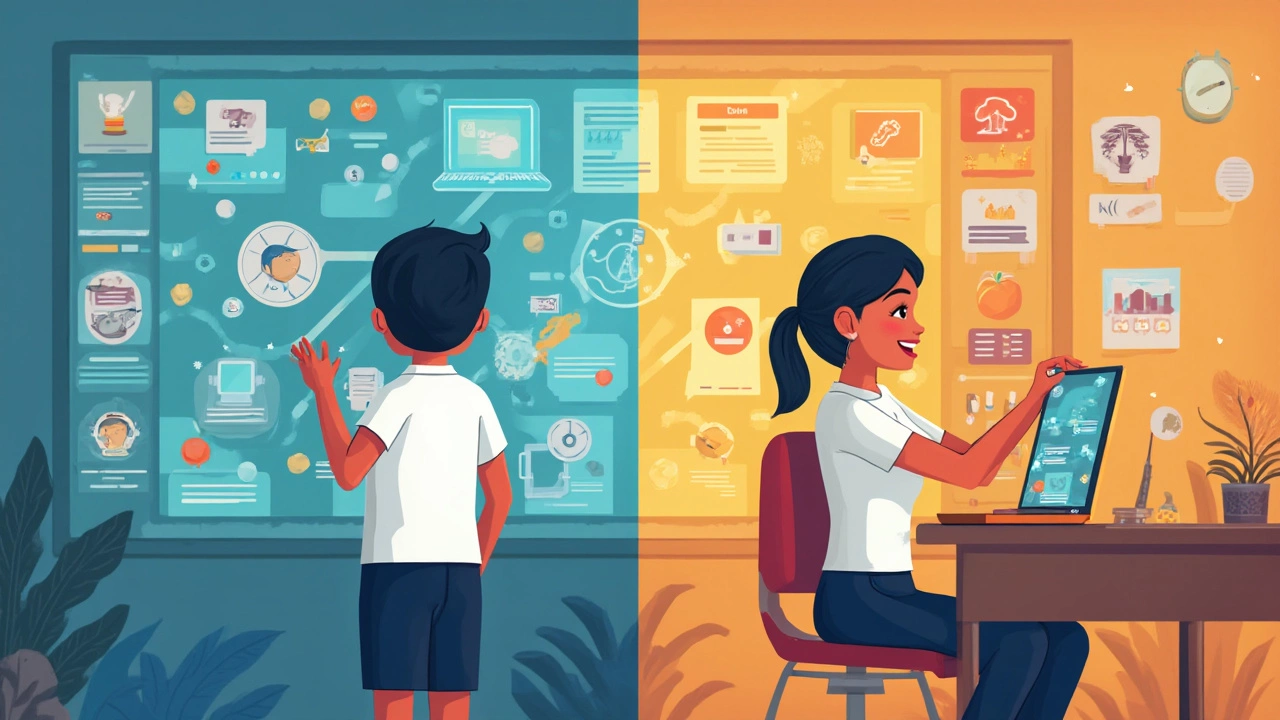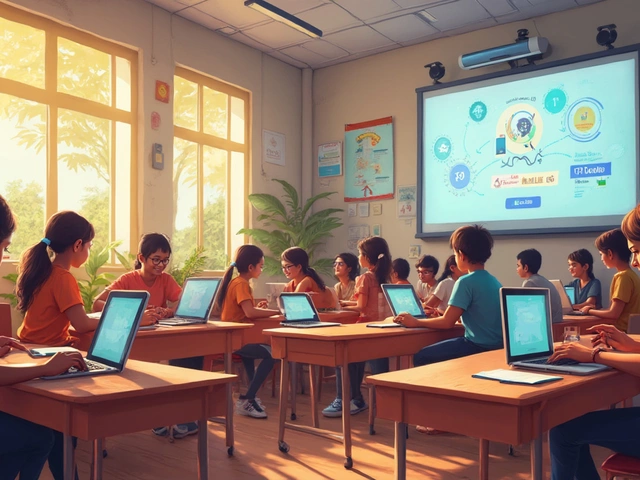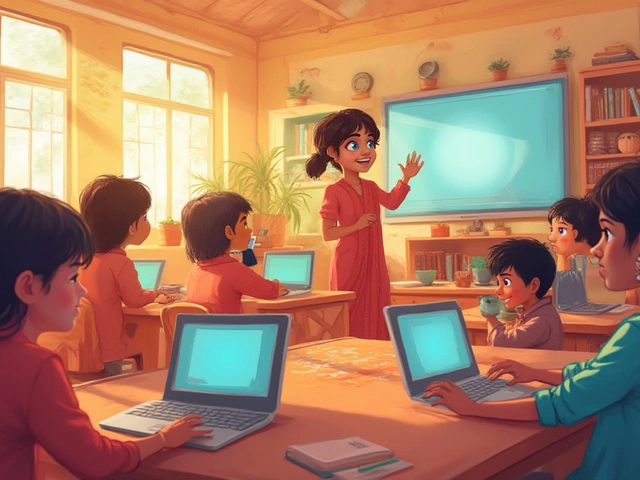Think back to the last time you tried helping your kid log into an online class, only to get stuck on the home screen. Been there? You’re not alone. A good e-learning platform shouldn’t feel like a maze. It’s got to be simple to use, no tech degree required. The login should be quick, dashboards should be clear, and finding lessons should be obvious—even for your grandma. The best platforms nail this right from the start.
But it doesn’t stop with buttons and menus. A good platform keeps you hooked. It’s not about flashy animations or random quizzes that feel like busywork. It should feel like you’re on a mission, not just clicking through slides. Whether it’s unlocking levels as you learn or getting instant feedback on mini-challenges, engagement is the secret sauce. If your kid finishes a lesson and asks for more, you know the platform is doing things right.
- User-Friendly Design: Keeping It Simple
- Engagement: Making Learning Stick
- Tech Tools for Teachers and Students
- Content Quality and Real-World Value
- Feedback That Actually Matters
User-Friendly Design: Keeping It Simple
Ever try to use an e-learning platform that has a crazy amount of menus, endless settings, and tiny buttons? Trust me, nobody’s got the patience for that. A clean design makes all the difference. Big platforms like Khan Academy and Duolingo have picked up on this—they keep things straightforward, so even if you’re new, you don’t waste time scratching your head. One big reason people ditch online learning? They just can’t find what they need.
Here’s the kicker: About 55% of learners drop out of online courses because the platform feels confusing or frustrating. If people need a tutorial just to use your e-learning site, that’s a red flag. Good digital platforms make stuff obvious: where to click, how to start, and where your progress sits. Visual clutter is gone, and helpful labels are front and center.
What separates the great platforms from the rest? Here are a few real-life pointers:
- Big buttons and clear icons—no squinting or guessing required.
- Easy-to-follow menus—everything grouped in a logical order.
- Helpful onboarding—quick pop-ups or a short welcome tour get new users comfortable in under five minutes.
- Mobile-friendly layouts—everything works smooth on phones and tablets, not just laptops.
Accessibility isn’t just a buzzword. Fonts must be readable and color contrast should be strong enough for everyone. Alt text on images helps users with screen readers. A platform can look minimal and still be full-featured for anyone with a disability.
| Feature | Helps Users (%) |
|---|---|
| Clear navigation | 86 |
| Mobile-friendly | 78 |
| Fast loading | 74 |
| Simple registration | 69 |
*Source: EdTech User Experience Survey, 2024
So, if you’re looking at a new platform for yourself or your kids, check how quickly you can find assignments, grades, and settings. If you’re clicking more than twice to reach what you need most, that’s a problem. Simple wins, every time.
Engagement: Making Learning Stick
If you ask students what makes them lose interest, the answer is almost always the same: boring, one-way lessons. Here’s the deal—digital learning works best when it feels like a conversation, not a lecture. The best e-learning platforms use polls, quizzes, real videos, and even memes. They don’t just post walls of text hoping you’ll stay awake.
Real engagement means thinking, doing, and getting feedback—all in rapid-fire mode. Take Kahoot, for example. Their live quizzes turn any dull subject into a mini-competition, which explains why they boast over 8 million teachers globally. Gone are the days of just reading and clicking “next.”
Here’s why interactive elements matter:
- Active participation beats passive watching: When learners interact, they remember up to 90% more of the material, according to a 2023 EdTech Influence Report.
- Instant feedback keeps motivation high: No one likes waiting days for results. Platforms that give comments or scores on the spot let students fix mistakes right away, keeping frustration low.
- Choices increase buy-in: Letting learners pick projects or paths boosts their sense of independence and ownership over learning.
Plus, not everyone learns the same way. Good platforms let you jump into real-life challenges, watch quick explainers, or even join live chats—so you never feel like you’re on your own island.
Curious how different engagement tools stack up? Check out this comparison:
| Platform Feature | Impact on Engagement | Bonus Points For |
|---|---|---|
| Live Polls/Quizzes | Up to 60% increase in participation | Real-time leaderboard |
| Discussion Boards | 35% boost in peer-to-peer sharing | Teacher replies within 24hrs |
| Game-Based Learning | Learners spend 90% more time on tasks | Badges, unlocked content |
Bottom line: engagement isn’t about fun for fun’s sake. It’s about making lessons stick in your brain, making you want to keep going—even when no one’s looking over your shoulder. When an app does that, it’s onto something big.

Tech Tools for Teachers and Students
Let’s face it: if the tech isn’t helpful, even the best platform lands flat. The real winners are the ones that make life easier for both teachers and students. For teachers, the top e-learning platforms bring a solid set of tools—not just to upload assignments, but also to track progress, spot trouble early, and save time grading.
Classroom management dashboards have changed the game. You’ve got places like Google Classroom that let you schedule, announce, and collect work without endless emails. Built-in video calls like on Zoom or Microsoft Teams make lessons way more interactive than emails ever could.
And students? They need features they’ll actually use. Stuff like:
- Instant chat for quick questions (think Slack or Discord, but made for school).
- Automatic reminders so nothing slips through the cracks.
- One-click access to resources—no digging through weird file folders.
- Voice-to-text or language tools to help kids who learn differently.
One teacher nailed it when she said:
“The right tech doesn’t get in the way; it clears the path, so you can focus on connecting with your students, not troubleshooting.” — Maria T., 5th grade teacher (quoted in EdTech Magazine, March 2024)
Numbers tell the story too! Here’s a look at how much time teachers say they save with the right tech tools:
| Tech Tool | Avg. Time Saved/Week |
|---|---|
| Automated Grading | 3.5 hours |
| Assignment Dashboards | 2 hours |
| Integrated Communication | 1.5 hours |
So, the bottom line: choose a platform that offers strong, practical tools everyone can use without a steep learning curve. Because when tech works, school just feels easier.
Content Quality and Real-World Value
If an e-learning platform is packed with glossy “bells and whistles” but doesn’t actually teach anything useful, it’s a waste of time. What matters most is the quality and usefulness of its lessons. The absolute best e-learning platforms break down tricky topics into language that’s easy to get, stacking lessons so you’re always building on what you know, not just guessing your way through random facts.
But here’s the big kicker: does the platform teach stuff you’ll actually use outside the website? My son Vivaan once breezed through an online science module using bite-sized videos, real-world case studies, and hands-on activities. I watched him fix our dripping tap with some of the skills he picked up. That's real-world value. The best content does more than prep you for tests; it gets you ready for life.
Want some signs you’re getting quality? Look for:
- Courses updated with current events or tech—think AI, online safety, or climate change.
- Lessons tied to practical skills—coding, writing emails, basic math for money management.
- Mix of formats: videos, podcasts, short quizzes, and interactive simulations.
- Trusted sources and clear author names. If you can’t see who wrote the lesson, that should raise an eyebrow.
Here’s what good content often looks like across subjects:
| Subject | Type of Useful Content | Real-World Value |
|---|---|---|
| Math | Budgeting tools, real-life problem sets | Managing allowance, understanding bills |
| Science | Experiments, case studies, news links | Doing home repairs, grasping daily news |
| Language | Email writing, interview tips, video stories | Communication, applying for jobs |
| Tech | Coding tutorials, cybersecurity tips | Safe browsing, creative projects, problem solving |
Data from a 2024 KPMG report shows students who used platforms with practical content scored 18% higher on applied knowledge tests than peers who used old-school, textbook-style platforms. That’s proof that real-world value isn’t just a buzzword—it genuinely lifts your skills.
Bottom line? If the lessons can’t be put into action, they’re not worth your time or money.

Feedback That Actually Matters
If you’ve ever heard a kid say, “So, did I get it right or not?” right after a lesson, you know feedback is a big deal. On e-learning platforms, feedback shouldn’t be some vague green check mark or a scary red X. It needs to tell you what you did well and exactly where you slipped up—right away.
The numbers back this up. According to a 2023 EdTech Impact report, students who got instant feedback showed a 30% boost in retention compared to those who waited a day or more. It matters for teachers too since instant feedback lets them spot who’s struggling before things snowball.
"Effective feedback must answer three major questions asked by a teacher and/or by a student: Where am I going? How am I going? Where to next?" — John Hattie, Professor of Education
So, what do top platforms actually do to make feedback useful? Here’s what separates the good ones from the rest:
- Instant, specific response: Explains mistakes on the spot, not hours later.
- Actionable tips: Suggests what to fix and how, so it’s not just about what’s wrong but how to improve.
- Personal touch: Uses language that feels warm, like advice from a coach, not an emotionless bot.
- Progress tracking: Shows you how you’re improving over time, not just in one quiz.
Here’s a quick peek at how real feedback features stack up on popular e-learning platforms as of late 2024:
| Platform | Instant Feedback | Personalized Tips | Progress Reports |
|---|---|---|---|
| Khan Academy | Yes | Yes | Yes |
| Duolingo | Yes | Yes | Partial |
| Google Classroom | Partial | No | Yes |
| Udemy | Partial | Partial | No |
If you want honest progress and less frustration at home (trust me, I’ve seen plenty), chase platforms that treat feedback like gold. Nobody learns from a silent screen. A few words in the right spot can change how someone feels about learning altogether.



